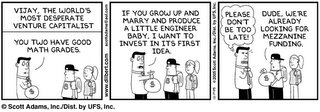Thanks to M.R.Rangaswami, the rich agenda of top industry execs, CIO’s and pundits at this year’s Software 2005 conference delivered a bird’s eye view of our $50 Billion industry.
The big picture that emerged for me was of an industry in transition. Not an industry shrinking, but one struggling to accept modest growth instead of meteoric growth. Again and again the themes that came through were customers rationalizing technologies and vendors protecting profits or searching for business models that actually work. In one session, industry analysts took turns predicting what percentage of software vendors will disappear over the next few years. Estimates ranged from 60%-80% failure rates from Gartner and Aberdeen. The only good news here in my view is that the analysts may consolidate even faster than the vendors.
CIO’s railed against quality problems, greedy vendors and the pain of an “annuity model” (i.e. paying 15% maintenance every year) for software vendors. They were clear that their main interest these days is not the next big innovation but rather making what they already bought work together. This is probably the 10th CIO session I have heard like this over the past few years. They also admitted to rising budgets and that they are trying some new things, even from startups. For their part, the big vendors all pitched stability, security, integration, etc, allowing us all some time for naps. Gone are the days of big vision.
As expected, Software as a Service (Saas) and Open Source Software (OSS) were the most interesting new directions. Still, the CIO’s were hesitant to endorse either, instead putting toes in the water. “A few experiments going” or “makes sense, so we are studying it.” Big vendors paid SaaS and OSS some lip service and were lucky to not get the tougher questions on the implications long-term. Still, these areas hold promise for the CIO’s and analysts. Unlike past years, no one (vendors, CIOs or analysts) was betting against SaaS or OSS.
There were some signs of industry impact from OSS. The low-end app server is already “gone” according to Forrester’s John Rymer. Everyone builds on Jboss or something free. Unilever runs an entire country’s operation on an open source stack…and it works. BP did a huge Linux server conversion and saved big bucks. I perceive that we are were close to some adoption tipping point on this topic. Only last year, the tone was more hesitant, with most vendors and CIO’s waiting for someone else to make the first move. Now they all seem a bit defensive that they are not doing more toward the OSS vision. Look for more motion here. Once the fashion leaders move, the lemmings follow quickly.
To the surprise of no one, off-shoring was another enduring trend in the industry. Aberdeen claims that 90% of firms surveyed are doing some work in China. Forrester sees the trend only just beginning. Look for more and more software companies to do more and more outside the US, while IT shops do the same.
The CEO panel was a good microcosm of our industry. The discussion centered on such entrepreneurial topics as SOX compliance, M&A for success, ensuring profitability and employee retention. These were not fun, but show that this industry is maturing just as it should. Big players are getting bigger (I think this was what Chuck Phillips took an hour to say in his keynote, but I might have dozed off), and the customers are trying to avoid being locked in and continue to look to new vendors for new capabilities. One survey cited said that only 35% of customers would trust their current large vendors to add new components.
In all, middle age may not be all that bad for the industry. We all knew somewhere in the back of our heads that markets don’t double every year for to many years. Maybe the world never really needed the 300 supply chain management companies the VCs spawned. But now that there are only a 30 or 40, perhaps some can actually make money…

